During WWII, Daniels worked as a civilian designer for the US Army and devised a way to equip the radio receiver/transmitter in military vehicles with a system that made them unaffected by engine noise. After the war, he set up shop in New Jersey Sears and Roebuck and Montgomery Wards when he was contracted to build amplifiers to be sold under each stores brand names. Respectively these names were Silvertone and Airline.
Around 1954, the Sears Company asked if he could build an affordable guitar. Although he was not a luthier, he said yes he could build it What he came up with is the Danelectro/Silvertone instrument that for some of us, may be the first guitar we owned. Though it appeared to be a solid body instrument, the Danelectro guitar was ingeniously designed.
It was built on a poplar wood frame. A neck block ran through most of the body, which allowed the bridge, be it fixed or vibrato, to be properly anchored. The body struts and the block were stapled together. In later years, the neck block was shortened and a wood block was glued to the inner side of the guitars back. This anchored the bridge. What made Danelectro guitars unique was the material used for the body. Both the top and bottom of the guitar was made of masonite, with a formica covering.
The neck, which was made of aged poplar, was topped with a rosewood fretboard and a metal nut.Daniel devised a system of using an automated table saw to precisely cut the necks. Though the neck did not contain an adjustable truss rod, Daniel had placed a ¾” aluminum rod in the neck to prevent warpage. He studied and determined that an inexpensive steel rod provided better reinforcement than an adjustable truss bar. Later twin steel I-beams replaced the rod. The tuners were inexpensive, but sturdy. Employing rods in the neck, allowed the neck more slender than other guitars of the day, providing ease of playing, which was especially good for younger players.
It was built on a poplar wood frame. A neck block ran through most of the body, which allowed the bridge, be it fixed or vibrato, to be properly anchored. The body struts and the block were stapled together. In later years, the neck block was shortened and a wood block was glued to the inner side of the guitars back. This anchored the bridge. What made Danelectro guitars unique was the material used for the body. Both the top and bottom of the guitar was made of masonite, with a formica covering.
The neck, which was made of aged poplar, was topped with a rosewood fretboard and a metal nut.
His pickups were unique, wound for low output, 4.75k ohms, and housed in lipstick tubes. The lipstick tube provided shielding. The slight gap between the two ends prevented a loss of high frequency response.
His guitars came with one or two pickups. On the two pickup models, he wired the pickups in series, which gave the guitar a boost in sound when the two pickups were both in the on position. Most manufactures wire pickups parallel.
On the two pickup models, the controls were two sets of concentric knobs, with the volume on top and the tone on the bottom.
His guitars came with one or two pickups. On the two pickup models, he wired the pickups in series, which gave the guitar a boost in sound when the two pickups were both in the on position. Most manufactures wire pickups parallel.
The first of the Daniel guitars did not have the lipstick tube pickups, although the inner workings were similar. The pickups on these first models were routed into the wood. In subsequent years, Danelectro purchased lipstick casings from a cosmetics manufacturer, then sent to another business for chrome plating.
The knobs and switches were similar. Most Danelectro guitars utilized an interesting fixed tailpiece. This was a trapezoidal metal unit attached to the wood block in the body by three screws. The saddle was a thin strip of rosewood.
The vibrato unit on a few Danelectro/Silvertone guitars was similar, except the metal plate moved on it self, in the same manner asGibson ’s vibrola unit.
The vibrato unit on a few Danelectro/Silvertone guitars was similar, except the metal plate moved on it self, in the same manner as
Once the frame was made, white glue was brushed on the its perimeter and adorned with rippled cloth tape. The poplar body frames were topped with a covering of masonite on the front and back. A melamine pickguard provided the final addition to the body.
The biggest reason Sears and Wards preferred Daniel ’s product was its low cost and high quality. For most working families it made sense to buy junior a $90 Silvertone guitar, instead of a new Fender Stratocaster, which cost $329.
The shapes of the guitars and basses were well thought out and somewhat mimicked the Gibson styles with one or two cutaways. The exception was the Longhorn guitar and bass. I always thought the body looked like a lyre-harp, with its twin horns and large soundboard. Around 1966 or 1967, there was an American TV show called Shindig. I was fascinated by the bass player’s instrument.
It was a Danelectro longhorn bass. It had a short scale and an antiqued finish. The body was an off-white colour with a gilded perimeter.Daniel
It was a Danelectro longhorn bass. It had a short scale and an antiqued finish. The body was an off-white colour with a gilded perimeter.
Danelectro had several headstock styles. Many Sears/Silvertones came with the “dolphin” style six-on-a-side (or four-on-a-side for bass) headstock. The other style came to be known as “the Coke bottle” headstock, due to the appearance being similar to the shape of a 6 ½-ounce Coca-Cola bottle.
Danelectro guitars had DANELECTRO written in white lettering on the headstock. Many Silvertone guitars came with a silvered plastic emblem that spelled SILVERTONE, which was glued to the headstock.
At the time, 90% of Daniel’s guitars and amplifiers sold through Sears or Montgomery Wards. Most guitarists knew who Leo Fender was, but few were aware of Nathan Daniel, because his name was not on the products.
Back in the day, two of my friends owned Silvertone amplifiers. The Twin-Twelve model 1484 was probably the most desirable of his amps.
The amplifier portion was housed in its own chassis, designed to be conveniently placed at the bottom of the speaker cabinet, when not in use.
The speaker cabinet contained two 12” Jensen special design speakers, that were wired in series. The amplifier had two channels with volume, treble and bass controls for each, reverb depth, tremolo strength and speed.
The amplifier portion was housed in its own chassis, designed to be conveniently placed at the bottom of the speaker cabinet, when not in use.
The speaker cabinet contained two 12” Jensen special design speakers, that were wired in series. The amplifier had two channels with volume, treble and bass controls for each, reverb depth, tremolo strength and speed.
Each channel had two input jacks, plus there was a jack for a footswitch that turned the tremolo and reverb on or off.
The three switches on the guitars lower front panel controlled were and on/off switch, a standby control and a ground control. The amp was loud enough for combo playing, rated at about 30 to 40 watts RMS and extremely clean, although the literature claimed it to produce 50 watts. Its price was less than $180.
Some of the features of the amp made it more affordable to produce, something Sears regarded as a plus factor.
The chassis and cabinet were made of particleboard and coated with a gray cloth material. The speaker baffle was made of a wood product called high-density fiberboard. The cord from the speakers to the amplifier was permanently attached instead of having input jacks and a separate speaker cord.
The reverb unit, probably made by Hammond, was smaller than those used on Fender amps, since it had to fit in the amp chassis. A player was able to coax a weird sound out of the amp, by turning the volume down and turning the reverb all the way up.
The reverb unit, probably made by Hammond, was smaller than those used on Fender amps, since it had to fit in the amp chassis. A player was able to coax a weird sound out of the amp, by turning the volume down and turning the reverb all the way up.
My other friend played bass and his first real amplifier was a Sears/Slivertone model 1483 bass amplifier. Like the 1484, this amplifier was a separate head unit and cabinet.
This useful feature prevented the speaker vibration from rattling the tubes. Both amps utilized twin 6L6GC power tubes. Due to the design it produced 25 to 30 watts of tube power.
The bass amp had two channels with volume, bass, treble controls and two inputs for each, a ground switch, an on/off switch, and a standby/operate switch. This amp had a 15’ Jensen special design bass speaker.
This useful feature prevented the speaker vibration from rattling the tubes. Both amps utilized twin 6L6GC power tubes. Due to the design it produced 25 to 30 watts of tube power.
The bass amp had two channels with volume, bass, treble controls and two inputs for each, a ground switch, an on/off switch, and a standby/operate switch. This amp had a 15’ Jensen special design bass speaker.
Like the Twin-Twelve, the cabinet was particleboard and the speaker baffle was again, high-density fiberboard. The bass frequency caused the baffle board to vibrate.
It also distorted, which is desirable today, but not so in 1965. Instead of the amp unit being stored on the bottom of the speak cabinet, it was stored vertically on the cabinets side. The model 1483 sold for under $130, which was much less than a Fender Bassman of that era. Silvertone offered an earlier model of this amp in a combo unit, known as model 1472.
It also distorted, which is desirable today, but not so in 1965. Instead of the amp unit being stored on the bottom of the speak cabinet, it was stored vertically on the cabinets side. The model 1483 sold for under $130, which was much less than a Fender Bassman of that era. Silvertone offered an earlier model of this amp in a combo unit, known as model 1472.
Daniel made smaller guitar tube amps for Silvertone that ranged from 2.3 watts to 15 watts. They were comparable to Fender’s Champ and Princeton line.
During the final years of Nathan Daniels association with Danelectro and Silvertone, he created two solid-state guitar amps and two solid-state bass amps.
The appearance of the guitar amps was similar to the tube versions. The model 1464 produced 100 watts of solid-state power into two-twelve inch Jensen speakers. The model 1465 was a monster that produced 150 watts of power into six-ten inch Jensen speakers. Due to its size, the cabinet came with built-in wheel casters. The amp unit had only an on/off switch.
During the final years of Nathan Daniels association with Danelectro and Silvertone, he created two solid-state guitar amps and two solid-state bass amps.
The appearance of the guitar amps was similar to the tube versions. The model 1464 produced 100 watts of solid-state power into two-twelve inch Jensen speakers. The model 1465 was a monster that produced 150 watts of power into six-ten inch Jensen speakers. Due to its size, the cabinet came with built-in wheel casters. The amp unit had only an on/off switch.
The bass models, included model 1463. This produced 35 watts of solid-state power into a 15 inch Jensen speaker, housed in a separate cabinet that was larger than the one for the model 1483.
The controls were minimal, just one channel with only volume, bass, treble potentiometers and an on/off-polarity switch.
The model 1466 produced an incredible 150 watts of energy into six-ten inch Jensen speakers, housed in a huge cabinet that was on coasters. Like the smaller unit, the controls were minimal, volume, bass, tone, and an on/off-polarity switch. Two large heat sinks were visible on the rear side of the head. The 1463 sold for $120 and the 1466 sold for $230.
The controls were minimal, just one channel with only volume, bass, treble potentiometers and an on/off-polarity switch.
The model 1466 produced an incredible 150 watts of energy into six-ten inch Jensen speakers, housed in a huge cabinet that was on coasters. Like the smaller unit, the controls were minimal, volume, bass, tone, and an on/off-polarity switch. Two large heat sinks were visible on the rear side of the head. The 1463 sold for $120 and the 1466 sold for $230.
I am not sure if Nathan Daniel was tired of the business or saw the end of the 1960’s guitar craze, but in 1966 he sold to MCA, which was a talent agency and record conglomerate, that thought they could make a go in the guitar business.
Their business strategy was to forgo the successful business as jobbers and deal directly with music stores. As part of the sale, Nathan Daniel retained the rights to the guitar designs. MCA acquired the Danelectro name, logo and patents for the stacked potentiometers. Because of this MCA needed a new product line.
Their business strategy was to forgo the successful business as jobbers and deal directly with music stores. As part of the sale, Nathan Daniel retained the rights to the guitar designs. MCA acquired the Danelectro name, logo and patents for the stacked potentiometers. Because of this MCA needed a new product line.
 |
| Bellzouki 12-string |
Bell also designed The Coral Hornet, which had a body shape similar to a Fender Jaguar or Jazzmaster.
The bodies of Coral guitars were made in Japan then imported to the United States to be fitted with necks and electronics.
From the start, Mr. Daniel had recognized his product was not the same as Fender or Gibson and avoided dealing directly with retailers. MCA’s plan to eliminate the jobbing business was a failure. By 1969, they shut the door on Danelectro.
A fellow named William Herring purchased the assets of Danelectro for $20,000. He turned to Ampeg as a way to unload some of his existing stock.
Ironically, another Daniel, Dan Armstrong, was involved with Ampeg at the time, marketing his Lucite clear guitar, or at least making an attempt. Ampeg was having some production problems with the instrument. Armstrong states Ampeg purchased 650 to 700 single cutaway Danelectro masonite guitars.
The story is somewhat fuzzy, but suggested these guitars were given to Armstrong in lieu of cash. Armstong then modified the guitars.
He removed the existing lipstick tube pickup and replaced it with a humbucking pickup of his own design with a plastic surround. The electronics were changed as well and a clear pickguard was that bore the phrase, “Dan Armstrong / modified Danelectro.” A sticker was placed on the back of the guitars that announced Ampeg Co and the Danelectro logo on the headstock was painted over.
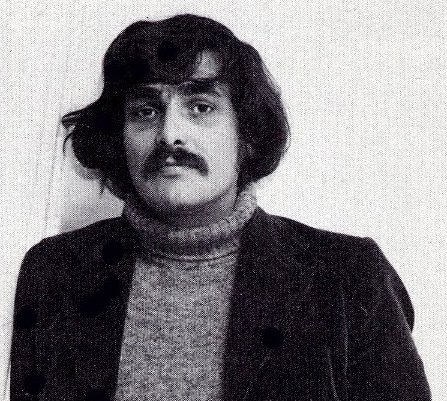 |
| Dan Armstrong |
The story is somewhat fuzzy, but suggested these guitars were given to Armstrong in lieu of cash. Armstong then modified the guitars.
He removed the existing lipstick tube pickup and replaced it with a humbucking pickup of his own design with a plastic surround. The electronics were changed as well and a clear pickguard was that bore the phrase, “Dan Armstrong / modified Danelectro.” A sticker was placed on the back of the guitars that announced Ampeg Co and the Danelectro logo on the headstock was painted over.
Unimusic, the company that now owned Ampeg, was in financial trouble and was unable to pay William Herring for the inventory he sold to them. Herring filed a lawsuit. It was later determined much of the existing MCA surplus was stored away in chicken coups and destroyed by the elements.
A Nashville, Tennessee guitar builder named Jerry Jones saw a market for Danelectro style instruments in Nashville and received permission from Nathan Daniels to build copies of Daniels guitar designs without the stacked potentiometers. Jerry Jones Dano-style guitars became extremely popular, especially with local studio players, that added them to their collection.
A fellow named Anthony Mark acquired the Danelectro trade name, logo andpatent to the stacked potentiometers and a lot of the unassembled Danelectro and Coral parts.
In the 1990’s, Steve Ridinger purchased the rights to the Danelectro name and logo. He then set up the Evets Corporation and set about building replicas of the Danelectro line up, the instruments now being made in Asia. The bridge and saddle became updated to a modern style adjustable unit, although the current model reverts back to the original rosewood bridge.
Jerry Jones was still building Danelectro style guitars, with his name on the headstock. Evets filed a lawsuit against Jones.
 |
| Jerry Jones Neptune |
The suit was dismissed, since Evets did not have any rights from the Daniels Estate. Jones continued to build Dano style guitars up until his recent retirement, although they were slightly modified from his original design.
The Evets Corporation began by offering quite a line-up, including some models, such as the Ho-Dad, that was in no way similar to a Dano. The company’s present strategy is to build only one style of guitar and bass per year and offer it for sale.
The Evets Corporation has adhered to Mr. Daniels philosophy, that they are not Fender or Gibson, but filling a niche market for inexpensive, but quality guitars.
Evets offers a variety of guitar related products, including practice amplifiers, their unique brand of tone-shaping pedals and an inexpensive, adjustable-voltage power transformer.
The old stock of Silvertone amplifiers is all that is left. A new company has acquired the Silvertone brand name and is importing guitars and solid state amplifiers.
However the older models of Danelectro and Silvertone amps were built to last. As tube amplifiers they can be bargains.
Nathan Daniel deserves credit, not just for his wonderful guitars and amplifiers, but for the innovations that he introduced to the music industry.
The following list of Mr. Daniels inventions is from a tribute by his son, Howard Daniel:
• the first six-string electric bass (1956)
• the first 12-string electric guitar (1961 – the “Bellzouki,” developed in collaboration with Vinnie Bell and inspired by Greek bouzoukimusic from the film classic “Never on Sunday”)
• a 31-fret “Guitarlin” (1958) with a deeply cut-away “longhorn” body that enabled a guitarist to play an extra 10 frets into the mandolin range
• an amplifier and speaker built into a guitar carrying case (this was done for Sears, which sold the Silvertone “amp-in-case” and guitar for under $50 as a set for novice players)
• a “convertible” guitar that could be bought, inexpensively, for beginning students, as an acoustic, and later, with the purchase of a pickup kit, turned into a semi-hollow-body electric
• total shielding of guitar and amplifier circuits to protect against hum from neon signs, motors or other sources of electrical interference (he introduced this at a National Association of Music Merchants – NAMM – show, with Vinnie Bell demonstrating Danelectro guitars and amps while sitting right next to a glowing neon sign; the Danelectro products sounded crystal clear, while a specially assembled “Brand X” guitar, lacking the shielding, hummed noisily every time Vinnie plugged it in)
• guitar necks that never warped because they were reinforced with twin steel I-beams
• the use of inexpensive, yet strong and stable composite materials in both amplifier cabinets (Homasote, particle board) and guitar bodies (Masonite, Formica)
• a guitar neck-tilt adjustment system “nearly identical [as Washburn and Soest wrote in Guitar World] to the one Fender used – except that Danelectro did it a decade earlier and didn’t bother to patent it'
• a “master-slave” amp system with 300-plus watts of distortion-free power (back in 1956)
• a "hexaphonic" guitar, with each string having its own separate pickup, amplifier and speaker (1958 - but never manufactured)
• a capacitance pickup for classical guitar with a tube pre-amplifier built into the body; etching the nylon strings and coating them with graphite made it possible to pick up the signal (1959 - but never manufactured )
• a hybrid vacuum tube/solid-state amplifier (1968)
• the first six-string electric bass (1956)
• the first 12-string electric guitar (1961 – the “Bellzouki,” developed in collaboration with Vinnie Bell and inspired by Greek bouzoukimusic from the film classic “Never on Sunday”)
• a 31-fret “Guitarlin” (1958) with a deeply cut-away “longhorn” body that enabled a guitarist to play an extra 10 frets into the mandolin range
• an amplifier and speaker built into a guitar carrying case (this was done for Sears, which sold the Silvertone “amp-in-case” and guitar for under $50 as a set for novice players)
• a “convertible” guitar that could be bought, inexpensively, for beginning students, as an acoustic, and later, with the purchase of a pickup kit, turned into a semi-hollow-body electric
• total shielding of guitar and amplifier circuits to protect against hum from neon signs, motors or other sources of electrical interference (he introduced this at a National Association of Music Merchants – NAMM – show, with Vinnie Bell demonstrating Danelectro guitars and amps while sitting right next to a glowing neon sign; the Danelectro products sounded crystal clear, while a specially assembled “Brand X” guitar, lacking the shielding, hummed noisily every time Vinnie plugged it in)
• guitar necks that never warped because they were reinforced with twin steel I-beams
• the use of inexpensive, yet strong and stable composite materials in both amplifier cabinets (Homasote, particle board) and guitar bodies (Masonite, Formica)
• a guitar neck-tilt adjustment system “nearly identical [as Washburn and Soest wrote in Guitar World] to the one Fender used – except that Danelectro did it a decade earlier and didn’t bother to patent it'
• a “master-slave” amp system with 300-plus watts of distortion-free power (back in 1956)
• a "hexaphonic" guitar, with each string having its own separate pickup, amplifier and speaker (1958 - but never manufactured)
• a capacitance pickup for classical guitar with a tube pre-amplifier built into the body; etching the nylon strings and coating them with graphite made it possible to pick up the signal (1959 - but never manufactured )
• a hybrid vacuum tube/solid-state amplifier (1968)
- A vibrato/tremolo system that he dubbed the Vibravox and a reverb system.
- A loudspeaker cabinet with inclined baffles that were designed to boost bass response by lengthening the sound wave path from the back to the front of the speaker. He called this the Acoustic Case.
When you look at this list it is amazing how many of these inventions were far ahead of their time and picked up by other guitar and amplifier manufacturers through the years.
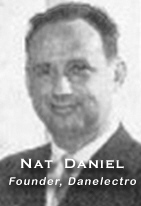

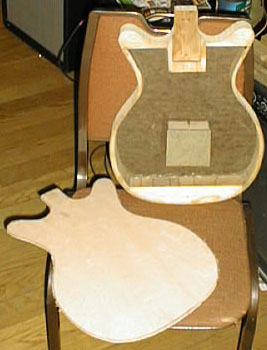













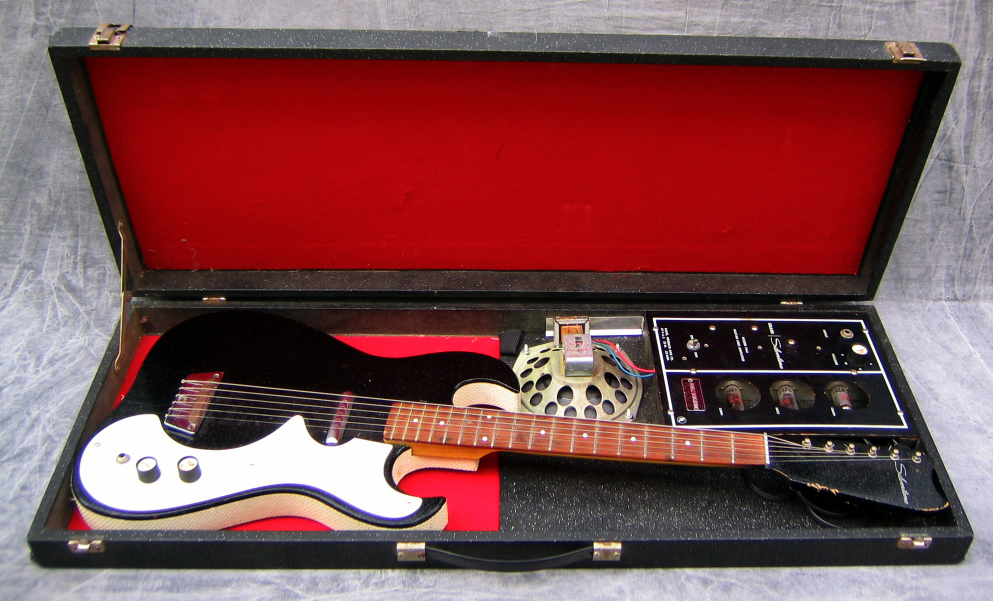
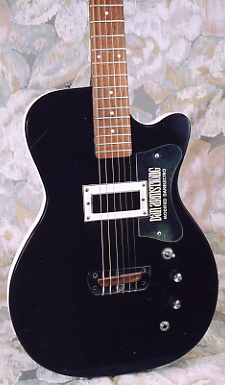

Tidak ada komentar:
Posting Komentar